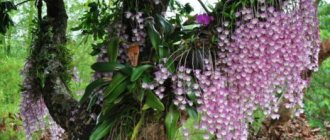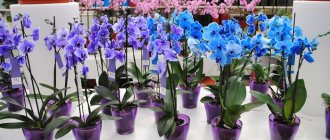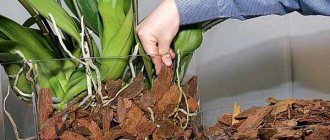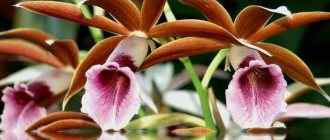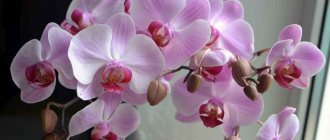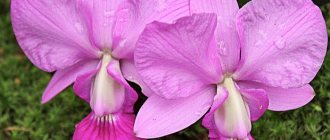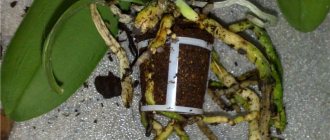Flower birthplace and origin
In nature, these plants can be found in Asia, Australia, the Philippines, and in places with a humid tropical climate.
The genus owes its name to K. Blume, the director of the botanical garden, who at dusk mistook an orchid flower for a butterfly. Phalaenopsis is a Greek word meaning “moth-like.” And indeed, in its shape it resembles this fragile creature.
In Ancient Greece they saw another similarity, with a slipper or shoe. However, such elegant shoes are not suitable for earthly creatures. She is worthy only of the feet of the Goddess of Beauty. Hence the name - Aphrodite's slipper.
Propagation of orchids at home
If you are growing orchids and have already become imbued with all its features, you can safely propagate your favorite specimen. Propagating orchids at home is a task for an experienced gardener. Orchids are propagated by: dividing large plants, lateral shoots, apical cuttings, pseudobulbs, pups, and seeds. You can read more about this here.
Application
For a long time in the East, these delicate plants were highly valued for their medicinal properties and were used to relieve severe pain and treat many diseases. It was also believed that potions made from the flower could prolong life.
Modern scientists have confirmed the medicinal properties of orchids. The assumption about the plant’s ability to give longevity has also been scientifically confirmed. It turned out that Phalaenopsis roots contain substances that activate the synthesis of the longevity gene. The presence of these substances explains their long flowering.
Today this flower is revered as a highly decorative plant and decorates our interiors.
Description of the plant
Phalaenopsis is an epiphytic plant of the Orchidaceae family.
Orchid grows on tree trunks and even rocks
The roots of Phalaenopsis both in their purpose and in structure. They are divided into main and subordinate ones. With the help of the main roots, the plant is attached to the tree trunk and always grows vertically, upward. Adventitious roots are located between the leaves and are aerial.
Sometimes they look very exotic, forming a “beard”
Like leaves, roots are capable of photosynthesis. This explains their unusual gray-green color for roots and their special structure, reminiscent of the tissues of succulent leaves that can retain moisture.
Orchids have a short stem with sessile large (from 7 to 30 cm) dense leaves of a rounded elongated shape located on it in pairs. On adult specimens there are from 4 to 6. During each year, 2 leaves appear, increasing the overall height of the plant.
The flowering of a plant begins with the appearance of a peduncle. It can branch, stretching up to 70 cm, and bears a large number of buds.
Thanks to the sequential opening of the buds, the flowering of orchids lasts for several months.
Phalaenopsis
The flower consists of 3 lateral sepals (sepalia), 2 lateral petals (petalia) and a central part, the so-called lip. Its task is to attract and accept, like a “landing site,” pollinating insects.
Phalaenopsis flowers can have the most incredible shapes and colors
Pests and diseases
Unfortunately, not everyone manages to properly care for orchids, which leads to infection with viruses, fungi, beetles, mites and arachnids. Falling flowers, yellowed leaves, covered with spots - this is the result of the work of pests. Most Popular:
- Thrips are insects that look like winged sticks; after entering a flowerpot, they gradually sink into the ground.
If there is a silvery net or dots on the leaves, it is most likely thrips. Wipe the leaves, remove damaged parts, treat the plants with actara. - Woodlice are not dangerous and are not parasites of orchids, but they gnaw at young roots and shoots. It’s easy to remove them; just water the plant abundantly. The insects crawl out and are not difficult to collect.
- Mealybug is a pest that feeds on sap from leaves. Lives at the base of the flower and under the roots. Forms colonies in the form of a web covering parts of the leaf blade. Remove fallen and damaged leaves, treat the plant with Fitoverm; if there are no parasite eggs within four weeks, consider the plant healthy.
Rust is a mold that attacks the leaves of a plant. Rusty spots appear on the surface of the sheet. Treatment: throw out the affected leaves, treat the plant with 25% alcohol.- Rot - this disease affects plants that are already infested with pests. Fluffy spots appear on the dorsal surface of the leaf - the methods of control are the same as in the previous paragraph.
- Aphids , a parasite in itself, are not dangerous, but excrement disrupts the process of cellular respiration in phalaenopsis, which promotes the proliferation of fungi and bacteria.
- Nematodes are protostomal parasites that weaken the plant by penetrating the roots and stems and feeding on sap. Orchids stagnate in growth, after which they rot and die.
We invite you to watch a video about diseases and pests of orchids:
Species composition
The genus Phalaenopsis is diverse and has about 70 species of plants, differing in size, color of leaves and flowers. Several of them are found indoors.
Phalaenopsis nice
A medium-sized species, distinguished by long, up to half a meter, leaves, painted in dark shades of green. It blooms twice a year, shooting out a peduncle with many buds.
Large white flowers with a yellow or reddish lip develop from the buds
Phalaenopsis Schiller
Differs in leaf color. Their lower part has a reddish tint.
The upper side of the leaves is covered with dark green spots
The graceful buds of this orchid are painted in white and purple tones, the central part has a leopard color.
Flowers of plants of this species are the height of grace
Phalaenopsis Stewart
It is characterized by a branching peduncle and unusual flower color.
The petals are white and the lip is golden yellow with bright purple spots.
Phalaenopsis Luddemann
Differs in compact sizes. Its leaves (up to 25 cm) are colored light green, and the peduncle bears no more than 7 buds.
Small (up to 7 cm) pink and lilac flowers exude a pleasant delicate aroma
The undeniable advantage of this species is its long flowering, almost all year round.
Phalaenopsis giant
It is impressive in its size: the leaves grow up to 1 meter in length. The plant throws out several flower stalks, each of which reaches at least half a meter.
Peduncles bear more than a dozen buds
Features of white orchids
The structure of the plant is not too different from other Phalaenopsis species. Depending on the type, dimensions can reach up to 1 meter or be limited to 30-40 cm. The main feature is the snow-white color of the petals during flowering. This type is perfect for keeping in an apartment where there are allergy sufferers. Unlike other species, the White Orchid does not have an intrusive odor.
Main features of this exotic beauty:
- size from 30 cm to 1 m;
- flower color - white;
- there is no smell.
Flower meaning
Translated from Latin, the name White Orchid sounds like “descended from God.” A variety of orchid belonging to the Phalaenopsis variety, translated as “butterfly”. This name was assigned to the flower by the famous botanist Blume. It is due to the unusual shape of the peduncle, similar to moths frozen on the stem.
The orchid has always been considered a symbol of wisdom, aristocracy and sublime feelings. As with a rose, the meaning of a flower changes depending on the color of the petals. Orchids with richly variegated petals signify pure passion, while soft, muted tones symbolize homeliness and warmth.
White orchid has several meanings:
- pure love;
- harmony;
- beauty.
Reference! Different countries have their own legends that define the meaning of the white orchid.
History of breeding
The first attempts to breed Phalnopsis in the European climate were made back in 1510. The Spanish conquistadors, fascinated by the beauty of the unusual plant, made the first attempts to transport it to Europe. However, all brought specimens died due to unsuitable weather conditions and inept care.
Cultivation in the European climate became possible only 200 years ago. The British were the first to achieve success. They managed to determine the correct care and achieve full flowering of the orchid. The Chinese took over the baton after them, starting to actively grow the crop. Subsequently, the unusual flower spread throughout the world.
Breeders have developed several varieties, the cultivation of which in an apartment is not particularly difficult. These types include:
- Ravella;
- Ravenna;
- Red Dion;
- Pulsation.
Growing
There is an opinion that orchids are capricious, finicky and require careful care. This deters many from purchasing them. There is some truth to this assumption. For favorable growth, Phalaenopsis requires high humidity air, which is problematic for most rooms, especially in winter.
Air humidity requirements
Humid air, from 50% and above, is what this beauty needs, first of all . Otherwise:
- its leaves and roots will lose their elasticity;
- the roots will acquire a grayish tint and lose their elasticity. They will not restore their structure and color even after watering;
- the plant will drop its buds and refuse to bloom.
Urgent measures to humidify the air can be:
- a container of water placed in close proximity to the orchid;
- batteries covered with a damp cloth;
- spraying the plant repeatedly throughout the day.
Optimal temperature conditions
Phalaenopsis feels good at air temperatures from 15 to 25 ° C. It is important for him:
- absence of nearby heat sources, for example, central heating radiators. In close proximity to them, the plant does not bloom so readily.
- Elimination of not only the action, but also the occurrence, even short-term, of drafts.
Keeping orchids at temperatures below 12 degrees is detrimental.
A favorable moment for the development of Phalaenopsis is the difference between night and day air temperatures of at least 5 degrees.
Lighting
Phalaenopsis prefers bright places and long daylight hours (up to 12 hours), so in autumn and winter the plant will benefit from additional lighting.
With a lack of light (for example, short daylight hours), the plant goes into hibernation: it stops growing and blooming. The orchid leaves begin to stretch and darken.
The plant will “tell” about excess light by the appearance of plaque and spots on the leaves.
It is important to comply with one more condition: Phalaenopsis does not tolerate rearrangement. For her, any movement is stress, to which the plant can react by slowing growth and dropping buds.
Features of watering
1. Watering is carried out when the substrate is completely dry.
To determine the need for moisture, move away the top part of the soil, usually these are pine needles or pieces of bark, and feel the underlying layers.
Orchid does not tolerate waterlogging very well. Stagnation of water is unacceptable for it: the roots of the plant quickly rot. Less scary for her are “dry” periods, which can last from several weeks to a month. It will signal insufficient watering by drying out the tips of the leaves.
2. Phalaenopsis is watered “from below”, immersing the pot in a container of water.
It is advisable that the water level coincides with the edges of the pot. In order to “get enough” of water, an orchid needs 30-40 minutes. The pot is removed, allowing the water to drain thoroughly. If water gets into the axils of the leaves, it is carefully removed.
It remains to add that for irrigation you can only use soft, settled, or even better, filtered or boiled water.
Transfer
Phalaenopsis does not need frequent replanting: once a year is enough. It is better to replant an orchid immediately after the plant has finished flowering.
Transplant instructions
Carefully remove the orchid from the container. To do this, carefully remember the container from the sides. You can turn the pot upside down, keeping the plant from falling, or cut the pot with a knife. In any case, you should protect the roots from damage as much as possible.
Clean the roots from the substrate, carefully untangle them and carefully inspect them.
- Healthy roots are green. They are dense and hard.
- Diseased and dead roots are easily recognized by their darker color and “emptiness” to the touch.
The following are subject to removal:
- rotten, dried and damaged areas. It is better to treat the roots with a sharp knife disinfected in an alcohol solution, followed by treating the cuts and cracks with activated carbon or brilliant green.
- All old leaves and flower stalks.
3. After the manipulations, the plant is given time to recover, leaving for 2-3 hours.
At this time, prepare the container and substrate.
Recommendations for choosing a pot and substrate
The choice of pot is of great importance. By their nature, the roots of the plant are located almost on the surface. They love light and air. Therefore, orchids are planted in transparent pots that have large drainage holes at the bottom and sometimes on the walls of the container.
A transparent pot is also convenient for monitoring the condition of the roots. Decay, infestation by parasites, and poor health will not go unnoticed.
The correct size of the pot is also important. This plant begins to bloom only after the roots fill the entire container. When making a choice, follow the principle: the container should be a little small.
The choice of substrate is no less important. It should resemble natural. Therefore, the ideal combination would be a mixture of pine bark, sphagnum, charcoal and perlite. In rooms with very dry air, the amount of moss should be at least 1/3 of the mixture. The higher the air humidity in the room, the less moss is added.
Planting begins by filling the pot with drainage (expanded clay). We place the plant on the drainage and carefully fill the container with soil, sprinkling the roots on top.
Lighting, temperature, spraying
It is best to keep an orchid on an east or west window; you can also keep it in the back of the room under a white fluorescent lamp or under a phytolamp special for plants. Supplemental lighting is especially important in the autumn-winter period; the length of daylight should be at least 14 hours.
The optimal temperature in summer is +20-25°C, in winter +16-18°C. To stimulate flowering, it is important that the orchid experiences a temperature difference of 3-5 degrees between day and night. In winter, at temperatures above +25°C, almost no flowering is observed.
The great adaptability of phalaenopsis to the conditions of detention should be taken into account. Of course, if conditions are created that best match natural requirements, the orchid will live longer and bloom more often.
Leaves should be sprayed with settled water at room temperature regularly, at least 3-5 times a day, especially in winter when the heating system is on, when air humidity is very low.
During the flowering period, you need to spray very carefully, trying not to get it on the flowers - water causes brown spots to appear on the petals, which reduces the decorative effect and leads to the rapid fall of the flowers.
Reproduction
No matter how strange it may sound, Phalaenopsis can be propagated by a peduncle that forms in the spring. Trim it below the bottom bud. After this, place the plant in a bright place.
After three months, a sprout should appear on the cut of the peduncle, the future baby
Propagation by root cuttings
Remove the plant from the pot, freeing the roots from the soil.
Using a sharp, disinfected knife, carefully divide the root system into parts.
The sections are disinfected and dried, leaving the plant for several hours. Sections of the root part are planted in separate containers.
Reproduction by children
It happens that a baby appears next to the plant, and sometimes right on it, between the flower stalks.
When their own aerial roots appear, the baby is separated
Phalaenopsis
And then they are planted in a separate container and cared for like an adult plant.
Temperature, lighting and feeding for phalaenopsis orchids
Temperature. These plants, from the hot, humid Asian tropics, should be kept in a calm, warm environment. At night, the temperature should not fall below 15 °C, as lower temperatures cause weakening of growth and buds falling off. In fact, plants do better at higher night temperatures, such as 18°C
In winter, daytime temperatures for a phalaenopsis orchid should be 5 °C higher than nighttime, but in summer they can rise higher with the usual precautions against overheating
Light. Strong light produces small, dense plants that cannot develop well. In summer, phalaenopsis should receive less light - 5000-10,000 lux. In the fall, gradually increase the lighting for the phalaenopsis orchid to stimulate flowering and slightly compact the plants; in winter the best option is 15,000-20,000 lux.
Feeding. Phalaenopsis needs fertilizer. Fertilizer is applied to the osmunda every two to three weeks at a concentration of 1/2 teaspoon per 3.5–4 liters of water. More frequent fertilizing is necessary in the bark. As with other bark plants, an exact fertilizer dosage system has not yet been developed. Set the required frequency of watering and concentration of fertilizers for phalaenopsis orchids, carefully monitoring your pets.



